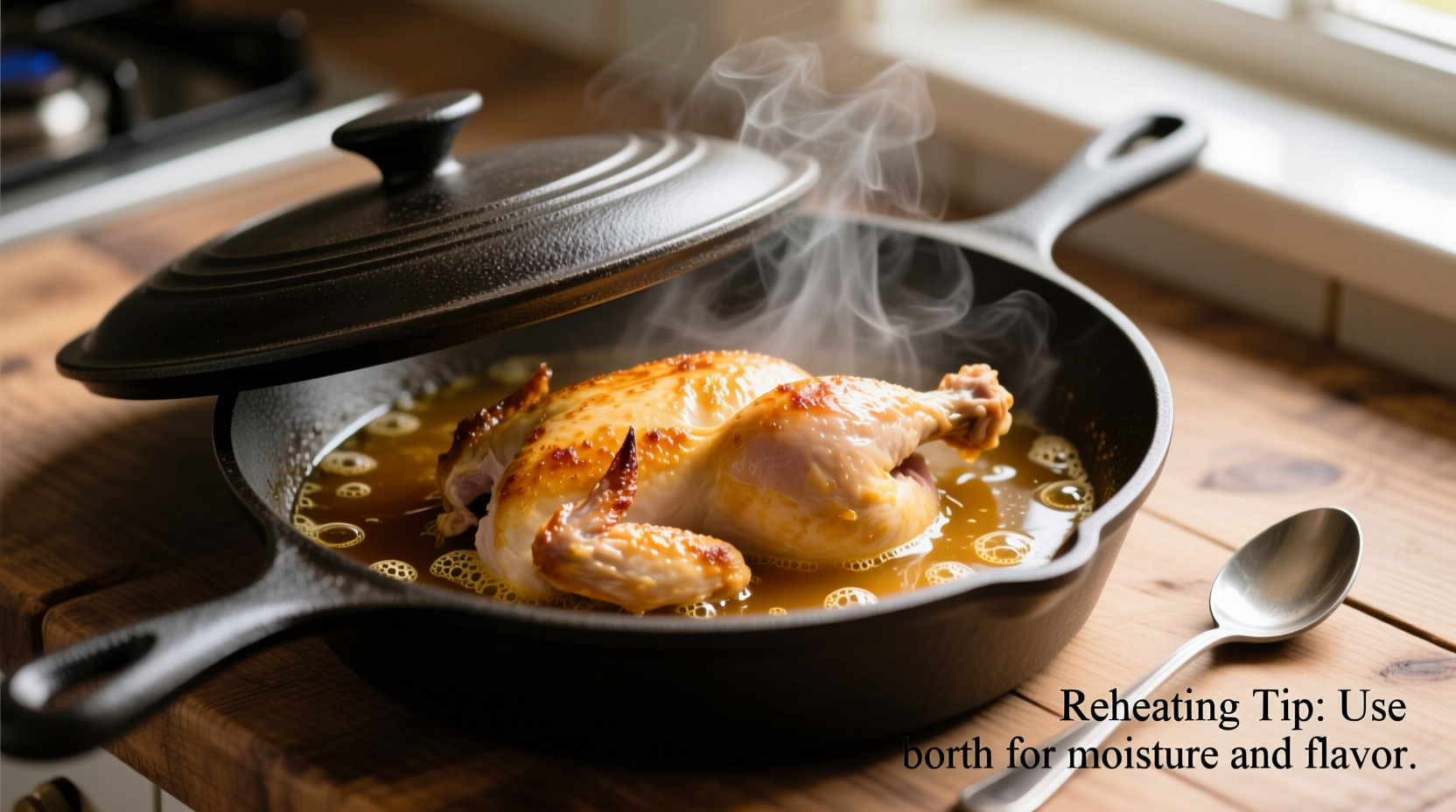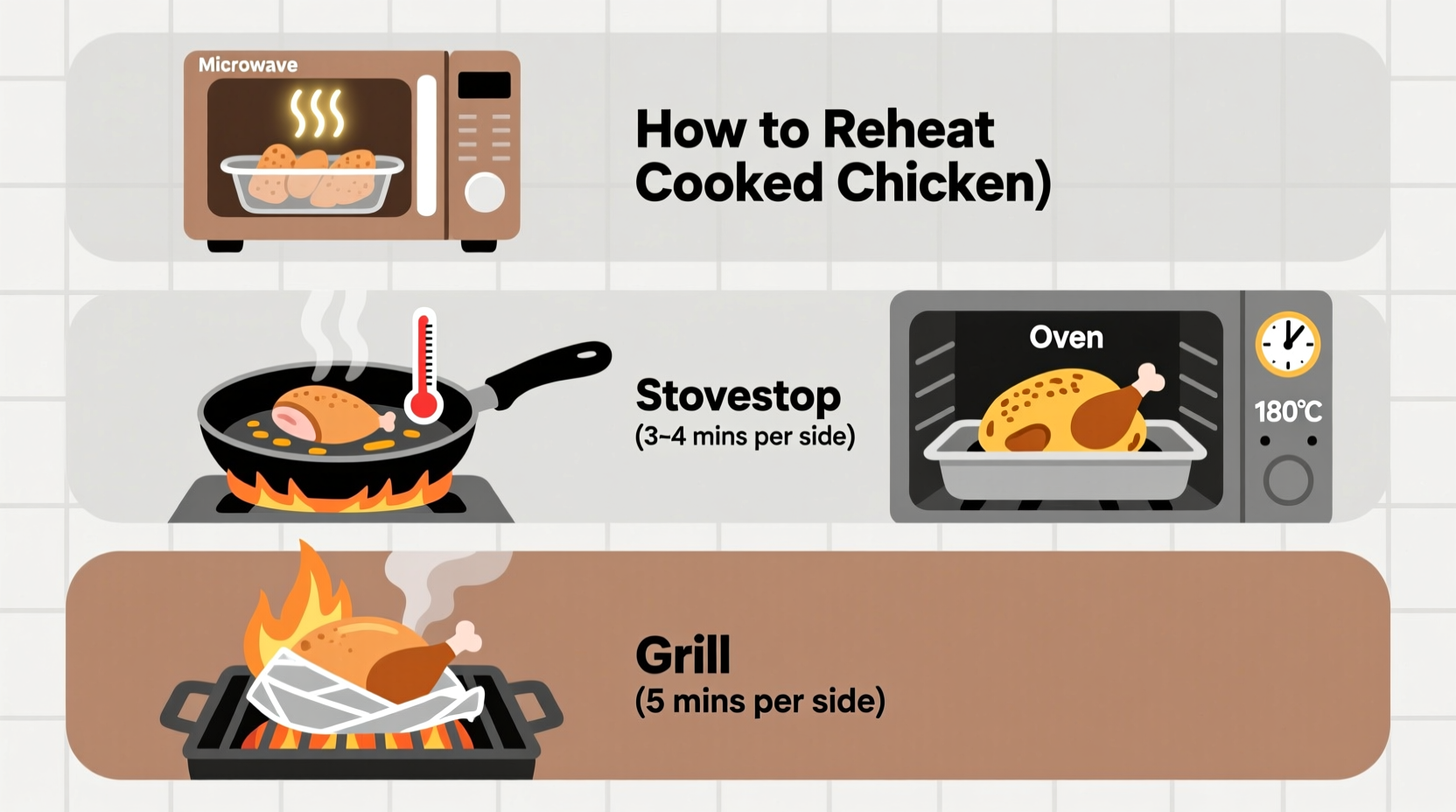Reheating cooked chicken wrong leads to rubbery texture or dangerous bacteria. As a chef with decades of kitchen experience, I've seen countless food safety mistakes. The only safe internal temperature for reheated chicken is 165°F (74°C), verified by a food thermometer per USDA guidelines. This critical step kills harmful pathogens like salmonella that thrive between 40°F–140°F. Below, I'll show you three professional methods that preserve juiciness while guaranteeing safety—plus exactly when reheating becomes risky.
When You Need Chicken Fast: Microwave Method (5 Minutes)
Use this for shredded chicken or small portions when time is critical. Never reheat whole pieces in the microwave—uneven heating creates cold spots where bacteria survive.
- Place chicken in a microwave-safe dish. Add 1–2 tbsp broth or water per cup of chicken
- Cover tightly with vented plastic wrap or damp paper towel
- Heat on 50% power in 60-second intervals, flipping pieces each time
- Check temperature in thickest part after 3 minutes. Stop immediately at 165°F
Pro Tip: Arrange pieces in a circle with thicker parts toward the outside. The USDA Food Safety and Inspection Service confirms microwaves heat unevenly—their research shows center portions can remain dangerously cold even when edges are scalding.
For Crispy Skin & Even Heating: Stovetop Method (10 Minutes)
Perfect for rotisserie or roasted chicken. This technique revives crispy skin while ensuring thorough heating. Requires constant attention—don't walk away!
- Heat 1 tbsp oil in skillet over medium-low. Add chicken skin-side down
- Pour in enough broth to cover bottom (1/4 inch)
- Cover skillet and cook 5–7 minutes until thermometer reads 165°F
- Uncover for final 2 minutes to re-crisp skin

| Reheating Method | Best For | Max Safe Time | Key Safety Check |
|---|---|---|---|
| Oven (325°F) | Whole birds, large batches | 25 mins | 165°F in thickest muscle |
| Stovetop | Skin-on pieces | 10 mins | No pink juices when pierced |
| Microwave | Shredded, diced chicken | 5 mins | Thermometer in multiple spots |
Oven Method for Juicy Results (20 Minutes)
Ideally for meal prep or whole chickens. Slow reheating locks in moisture better than high-heat shortcuts. Avoid the common mistake of using high oven temperatures—this dries out exteriors before interiors reach safe temps.
- Preheat oven to 325°F (163°C). Place chicken in baking dish
- Pour 1/4 cup broth or gravy over chicken. Cover tightly with foil
- Reheat until thermometer hits 165°F (15–25 mins depending on size)
- Rest 5 minutes before serving—this redistributes juices
According to CDC food safety data, cooked chicken left in the temperature danger zone (40°F–140°F) for over 2 hours enters high-risk territory. If your chicken was refrigerated within 2 hours of cooking, it's safe to reheat once—but never twice. The Food Safety and Inspection Service emphasizes: "Reheating multiplies bacterial growth risks with each cycle."—a critical context boundary many home cooks ignore.
Avoid These Dangerous Mistakes
- Skipping the thermometer: Visual cues like clear juices are unreliable. USDA studies show 1 in 4 people incorrectly judge chicken doneness by appearance
- Reheating at high heat: Causes protein denaturation that squeezes out moisture permanently
- Using dry methods: Never reheat plain in oven/microwave—always add liquid barrier
- Reheating twice: Each cycle through the danger zone multiplies bacteria exponentially
When reheating fails, it's usually because home cooks prioritize speed over safety. My professional advice: Build reheating time into your meal plan. The 5–20 minutes required prevents potential food poisoning that could hospitalize you for days. Remember—if chicken sat unrefrigerated over 2 hours, or shows slimy texture or sour smell, discard it immediately. No reheating method can reverse spoilage.











 浙公网安备
33010002000092号
浙公网安备
33010002000092号 浙B2-20120091-4
浙B2-20120091-4